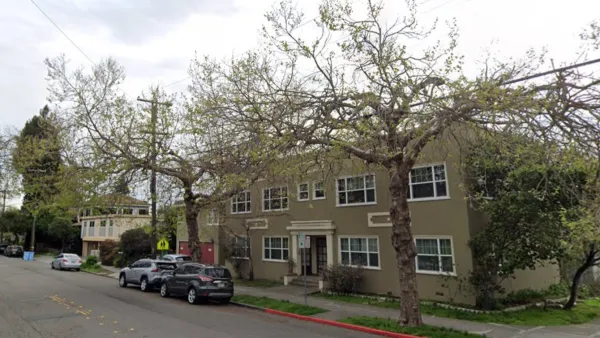Michael Hooper of Harvard University writes about a recent article in the Journal of Planning Education and Research

One of the toughest challenges facing planners is how to increase urban density in the face of often widespread opposition from a wide variety of actors, ranging from local residents to politicians. While densification is increasingly argued as an important component of efforts to combat climate change, and has been held to have other social and economic benefits, actually increasing density has proved challenging in many cases. The Urban Land Institute argues that there is a long history of failed densification efforts around the globe (Scott, 2015). Highlighting the complexity of densification, The New York Times profiled the conflicts surrounding proposed densification around a single lot in one of the paragons of progressive politics, Berkeley, California (Dougherty, 2017). But, what accounts for these tensions and the widely divergent opinions held concerning density? I examined this in an article recently published in the Journal of Planning Education and Research (JPER) titled “Flatulence, filth and urban form: Do primes for hygiene influence perceptions of urban density?”
One explanation for deeply divergent positions on densification is that, rather than being founded on “objective” features of density, these sentiments may be instead be premised on subconscious factors. Research in psychology and related behavioral sciences has argued that “most of a person’s everyday life is determined not by their conscious intentions but by mental processes…that operate outside of conscious awareness” (Bargh and Chartrand, 1999: 462). One aspect of the extensive work on these subconscious influences on perceptions has focused on “priming,” an effect in which exposure to one stimulus affects the response to another. Priming studies have shown that, for example, thinking about professors improves performance in Trivial Pursuit (Dijksterhuis and Van Knippenberg, 1998) and reading words associated with the elderly, such as “Florida,” is associated with people walking more slowly (Bargh, Chen and Burrows, 1996). Priming studies have become nearly ubiquitous in social psychology and related behavioral fields, but remarkably have very seldom examined urban contexts and have not addressed the issue of density. The JPER paper sought to rectify this gap by examining if perceptions of density were, like many other social, political and moral attitudes, malleable and open to influence through priming.
To explore the relationship between priming and urban density, I drew on a facility that Harvard maintains for conducting behavioral experiments. The Harvard Decision Science Laboratory has multiple rooms, each with separated computer terminals at which individual study participants can participate in tests and answer questions. For my study, I focused on primes, or cues, for hygiene due to the strong conceptual connection to urban density. The connection between ideas of hygiene and density is longstanding, with wealthy residents of dense medieval cities retreating to rural areas in times of plague and, more recently, with hygiene motivations figuring prominently in the rationale for many planning interventions, ranging from the creation of the Standard Zoning Enabling Act in 1926 to the growth of the suburbs in the mid-20th century.
The study involved 437 participants engaging in two visual preference surveys and two narrative scenarios. In answering questions about the visual preference surveys and scenarios, the participants were randomly assigned to four groups. In the first group, participants simply viewed and scored images of different density settings, which were drawn from the Lincoln Institute’s Visualizing Density Database, and answered questions about a prospective density increase in their neighborhood. Participants randomly assigned to the other three groups carried out these same tasks, but were subconsciously exposed to hygiene primes. These primes were chosen based on extensive past research that argues such primes can influence moral, political and social attitudes. The three primes were: being asked to hand sanitize before and after answering the questions; having a banana peel left on the keyboard and having to dispose of it in the trash before answering the questions; and being exposed to fart spray that had been introduced into the room at the start of the session (yes, you read that last one correctly!). Primes of each of these kinds have been shown to influence political and social attitudes and moral judgements and the goal was to see if perceptions of density were similarly open to influence.
The results of the study showed no consistent influence of hygiene priming on density perceptions. This is somewhat surprising given the very extensive body of research on priming that shows, thus far, that virtually all perceptions and attitudes can be primed. Had density perceptions been influenced by priming it might have opened up an array of subconscious interventions to modify these perceptions. While this perhaps sounds far-fetched, governments and the private sector have already begun to engage in such efforts, albeit not yet around urban planning topics. In the realm of public policy more broadly, for example, the UK government has established a Behavioral Insights Team, or “Nudge Unit,” that seeks to deploy behavioral insights to “enable people to make ‘better choices for themselves’” (UK Cabinet Office, 2018). In the private sector, priming research, such as studies showing the smell of chocolate is associated with people purchasing more books, has led companies to develop scenting technology that can distribute over 300 different odors into stores to influence customer preferences.
This study suggests that density perceptions are relatively stable to priming, a finding that has potential planning implications. In the face of the relatively small number of negative priming findings, the results of this study suggest that, at least with respect to hygiene primes, density perceptions are relatively stable. This in turn is likely to mean that efforts to change densities may meet with resistance and that densification strategies will have to be accompanied by extensive efforts to win over skeptical, and potentially difficult to convince, constituencies. Beyond addressing the issue of hygiene priming and density, the paper also argues for a greater attention to the behavioral dimensions of urban planning and for broadening the diversity of methods, including greater consideration of experimental methods, in the toolkit of planning scholars and practitioners.
References:
Bargh, J., and T.. Chartrand. 1999. “The Unbearable Automaticity of Being.”American Psychologist, 54(7): 462–79.
Bargh, J., M/ Chen, and L. Burrows. 1996. “Automaticity of Social Behavior: Direct Effects of Trait Construct and Stereotype Activation on Action.”Journal of Personality and Social Psychology, 71(2): 230-44.
Dijksterhuis, Ap, and Ad Van Knippenberg. 1998. “The Relation between Perception and Behavior, or How to Win a Game of Trivial Pursuit.”Journal of Personality and Social Psychology, 74(4):865–77.
Dougherty, C. 2017. “The Great American Single Family Home Problem.”The New York Times, December 1, 2017.
Groth, P.Living downtown: The history of residential hotels in the United States. Berkeley: University of California Press; 1994.
Scott, L. 2015. “Overcoming the Resistance to More Density.”Urban Land Magazine, July 6, 2015.
United Kingdom Cabinet Office. 2018. “Behavioral Insights Team.” Accessed June 15, 2018. https://www.behaviouralinsights.co.uk/.
Virginia Department of Health. “Scarlet fever, diphtheria, and disinfection.”Virginia Health Bulletin, 1(6): 216.
Full Article Open Access Until January 12, 2019
Michael Hooper, Ph.D., is an Associate Professor of Urban Planning at Harvard University’s Graduate School of Design (GSD). His research focuses on the politics of housing, land use and urbanization, with particular interest in issues of forced displacement, disasters and participatory governance.

Maui's Vacation Rental Debate Turns Ugly
Verbal attacks, misinformation campaigns and fistfights plague a high-stakes debate to convert thousands of vacation rentals into long-term housing.

Planetizen Federal Action Tracker
A weekly monitor of how Trump’s orders and actions are impacting planners and planning in America.

San Francisco Suspends Traffic Calming Amidst Record Deaths
Citing “a challenging fiscal landscape,” the city will cease the program on the heels of 42 traffic deaths, including 24 pedestrians.

Defunct Pittsburgh Power Plant to Become Residential Tower
A decommissioned steam heat plant will be redeveloped into almost 100 affordable housing units.

Trump Prompts Restructuring of Transportation Research Board in “Unprecedented Overreach”
The TRB has eliminated more than half of its committees including those focused on climate, equity, and cities.

Amtrak Rolls Out New Orleans to Alabama “Mardi Gras” Train
The new service will operate morning and evening departures between Mobile and New Orleans.
Urban Design for Planners 1: Software Tools
This six-course series explores essential urban design concepts using open source software and equips planners with the tools they need to participate fully in the urban design process.
Planning for Universal Design
Learn the tools for implementing Universal Design in planning regulations.
Heyer Gruel & Associates PA
JM Goldson LLC
Custer County Colorado
City of Camden Redevelopment Agency
City of Astoria
Transportation Research & Education Center (TREC) at Portland State University
Jefferson Parish Government
Camden Redevelopment Agency
City of Claremont






























